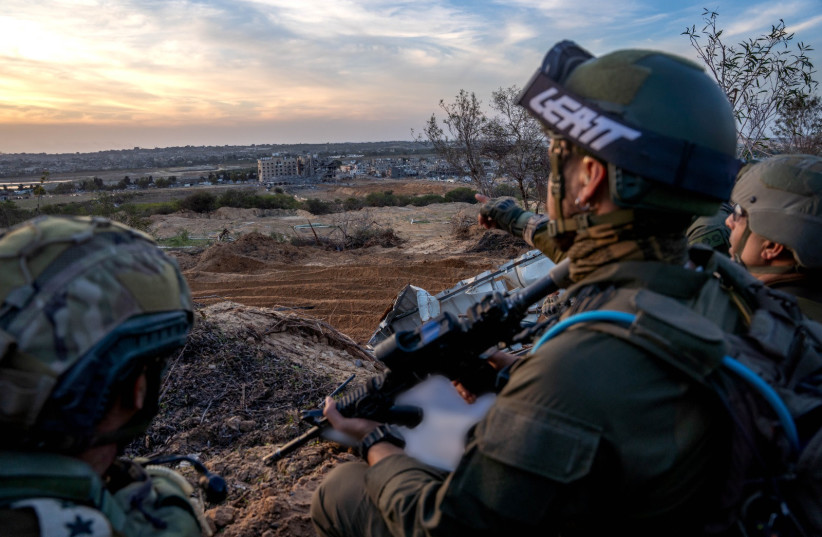IDF: Control of Gaza is split at several levels
The IDF currently is analyzing its control of different parts of Gaza at several levels from very significant to still non-existent.
On one end, there are parts of northern Gaza that are far along the way to being cleared of large Hamas forces.
Then, on the opposite end, there are parts of southern Gaza, like Rafah, and central Gaza, which have still essentially not even been touched by IDF ground forces.
What ground has the IDF covered?
In between there are places like Khan Younis in southern Gaza and Shejaia in northern Gaza where there is heavy fighting, and the IDF may not win broad control for some additional weeks or more, as well as places like Jabalia.
In Jabalia, the IDF has made significant progress toward control but still has several days or a bit more of fighting to truly eliminate large Hamas forces.
Each of these categories likely makes up between one-third to one-quarter of Gaza, leaving a picture of the territory that is far more complex than in IDF control/not in IDF control.
This spectrum of categories shows why disparate statements are being issued by different military and political officials about whether the “main war” can be wrapped up in around four weeks or closer to the end of January.

The number of reservists may already have dropped by well over 100,000 troops since 360,000 were called up, and at the point of the end of the “main war,” the number of reservists involved is expected to drop even more steeply.
At the same time, the IDF expects that both reservists and mandatory soldiers will need to serve longer periods going forward to maintain a larger force posture in and around Gaza as well as on the northern border with Lebanon.
A senior IDF official said, “We are seeing in recent days signs of breaking Hamas. The scope of the destruction and damage is creating command, control, and communications problems [for Hamas]. There are areas in Gaza where Hamas already has lost military control.”
“Despite the achievements, we are not close to the end of the war. We continue to act with great force and are taking apart full Hamas battalions. Half of the battalion commanders of Hamas have been killed,” continued the official.
IDF attacks until this point
Statistically, the IDF has undertaken 22,000 attacks, but it has still only killed 7,000 Hamas forces, with probably also several thousand additional wounded, and some several hundred arrested.
If two weeks ago, the IDF had taken apart a third or less of Hamas’s 30,000 forces, it may now be closer to around 50%.
It is unclear whether the IDF will have returned all hostages or killed or captured all top Hamas officials before the main part of the war concludes. In terms of taking over Gaza territory, a longer stage of cleaning out insurgents begins.
That longer stage is expected to last another three to nine months past January.
What will happen when the war ends?
The IDF is not publicly taking a position on who should run Gaza “the Day After” the insurgency is subdued but is preparing to have control of a variety of border security zones and to maintain the right to initiate raids against Gaza terrorists, even at a much later stage.
Despite global criticism, the IDF is mostly happy with its success in evacuating Palestinian civilians from more intense battle areas.
If there were 1.2 million Palestinians in northern Gaza on October 7, now the IDF estimates there are only 150,000, with there being around 800,000 in Khan Younis and 750,000 in Rafah, both in the South.
Those numbers mean that Khan Younis’ pre-October 7 population has doubled and Rafah’s has tripled.
There are also around 500,000 Palestinian civilians in central Gaza.
It is unclear when and whether the IDF will take control of the Philadelphi corridor between Gaza and Egypt and how that politically sensitive issue will impact how and when the IDF enters nearby Rafah.
Despite foreign reports about using water to flood Hamas out of its tunnels, that tactic is not expected to address the full tunnel threat, which will need many methods, including explosives and other technologies. It will also most likely take time.
In the North, the IDF has attacked around 106 Hezbollah positions, 52 lookout or intelligence gathering posts, 24 underground positions, and a variety of other targets.
According to the IDF, the price for Hezbollah has been much larger than the laconic phrases it has put out publicly. The military is seeking to send a message to the terror group about what the price of its firing on Israel is while simultaneously attempting to avoid a broader war.
The IDF will likely leave it to Hezbollah to clarify whether its attack on the terror group and an increase in troops and power on the border from the IDF will be enough to keep Hezbollah forces farther away from Israel, or whether the military will eventually need to escalate against Hezbollah.





Comments are closed.